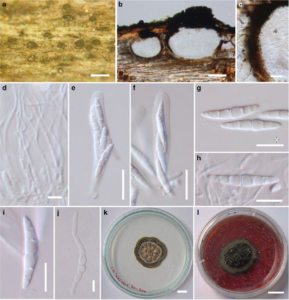Neolophiostoma pigmentatum S. Boonmee & K.D. Hyde.
Index Fungorum number: IF551405; Facesoffungi number: FoF00962; Fig. 1
Etymology – Pigmentatum, referring to the pigmentation produced in the culture media.
Holotype – MFLU 10-0062.
Saprobic on dead wood in terrestrial habitats. Sexual morph: Ascomata 146 – 231.5 μm high × 188 – 395 μm diam. (x̄ = 207 × 314 μm, n = 5), immersed, scattered to gregarious, partially erumpent at maturity, subglobose, unilocular, black, apically carbonaceous, with wide papilla, ostiolate. Peridium 24.5 – 27 μm wide, composed of dark brown, carbonaceous, occluded cells. Hamathecium comprising 1 – 1.5 μm wide, filiform, septate, branched, pseudoparaphyses. Asci 60 – 79 × 11 – 13.5 μm (x̄ = 68 × 12 μm, n = 10), 8 – spored, bitunicate, fissitunicate, cylindrical to subclavate, narrow towards the base, pedicellate or apedicellate, apically rounded, with an ocular chamber. Ascospores 24 – 31 × 5 – 7 μm (x̄ = 28 × 6 μm, n = 20), overlapping biseriate, hyaline, elongate – fusiform, narrow towards the sub-acute ends, slightly curved, 3 – 5 – septate, constricted at the median septum, surrounded by a thin gelatinous sheath, smooth – walled. Asexual morph: Undetermined.
Culture characteristics – Ascospores germinating on MEA within 12 h. Colonies growing on MEA, reaching 5 mm diam. in 1 week at 28 °C. Mycelium superficial, slightly effuse, thinly hairy, with mucous, radially striate with lobate edge, brown to dark brown, with reddish brown pigmented in media after 60 days.
Material examined – THAILAND, Chiang Mai, Mae Taeng, Huai Nam Dang, on dead wood of unidentified plant, 8 September 2009, Saranyaphat Boonmee, HND-02 (MFLU 10-0062, holotype); ex-type living culture, MFLUCC 10- 0129, BCC 52149, IFRDCC 2185.

Fig. 1 Neolophiostoma pigmentatum (holotype) a Appearance of ascomata on substrate b Section of ascomata c Close up of carbonaceous peridium d Pseudoparaphyses e, f Asci g – i Ascospores j Germinating ascospore k – l Colonies on MEA; note pigmentation in aged culture. Scale bars: a = 500 μm, b = 100 μm, c, e – f = 20 μm, d = 5 μm, g – j = 10 μm, k – l = 10 mm.
